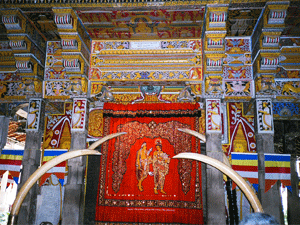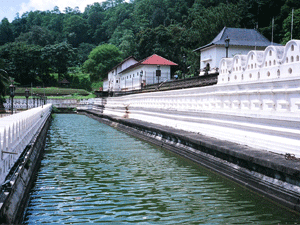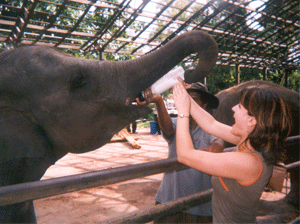The Mecca of Tea: Sri Lanka
- Written by Demet Cabbar
- Published in Travel
Demet Cabbar – Washington,DC
For people who spent their childhood in Turkey during the 80s, such as me, phrase “smuggled tea” are magic words. Although we didn’t have the answers to such questions as “where was this smuggled from, why was it smuggled” or “how did it end up in our kitchen”, it was impossible not to realize
For people who spent their childhood in Turkey during the 80s, such as me, phrase “smuggled tea” are magic words. Although we didn’t have the answers to such questions as “where was this smuggled from, why was it smuggled” or “how did it end up in our kitchen”, it was impossible not to realize
Even as a child, that smuggled tea had a special importance in our house. It must have been these magical childhood memories which made me feel I was visiting a well known country after a long absence when I traveled to Sri Lanka. Because Sri Lanka, or Ceylon in the past, is a country well known to us all, the magical friend of our childhood, the land of the “smuggled tea”.

Geographically Sri Lanka is an island of 65,000 square kilometers south of India in the Indian Ocean (approximately 1/12th of Turkey in size). The capital city is Colombo. The country is affected by northwest monsoons between December and March and by southwest monsoons between June and October. The seasons are divided in two: rainy and not rainy. The country, being affected by rain for 9 months, is just perfect for tea production. Hence, there is tea production in Sri Lanka year around without any intervals.
JAMES TAYLOR: DISCOVERER OF TEA
Sri Lanka is world’s third largest tea producer after India and China. Considering the size of India and China, and the little island of Sri Lanka, you can visualize the immense amount of tea production. Although the third largest producer, Sri Lanka is world’s largest tea exporter. According to BBC News, in 2002 Sri Lanka exported 291 million kilos of tea across the world (according to the statistics of the Indian Tea Board, Turkey’s export for the same year was 5 million kilos).
It is estimated that the tea plant was first introduced to Sri Lanka during the Dutch colonial period, but it was during the British reign that organized tea plantation and documentation started. According to the official documents, a sailor named James Taylor came to Sri Lanka and experimented with tea on 19 acres in 1867. James Taylor’s success opened a new era in Sri Lanka and tea plantations rapidly expanded throughout the island. In a short time Sri Lanka became known as “Ceylon,” the land of tea.

UNSOLVED TRAFFIC BALANCE
My hour long trip from the Sri Lanka International Airport to the capital city Colombo was one of the longest, and most colorful trips of my life. We tried to advance on a two way, long and narrow street, each with two lanes, through the chaos of other cars, cyclists, motorcyclists, horse- and ox-carts, pedestrians, and “tuk tuks” (three wheeled small vehicles), widespread because of their affordability and simplicity of use.
What is the traffic of Istanbul compared to this? From time to time I found myself thinking “Oh my god, we killed several cyclists!”, but a miracle happened and we continued our ride without injuring anybody. After a while I realized that this is the way traffic works in Sri Lanka. It has a balance, which I couldn’t understand. In this system, that seemed to me like a mixed soup, we finally managed to arrive at my hotel, the end of this miraculous journey, without hitting any other car or person, and I took a deep breath. And from the first day I admired the people of Sri Lanka, for managing to go from one place to another in such a chaos.
From the first moment I saw a tuk tuk, I decided to hire one as soon as possible. In the following days I hired one, and did a sightseeing tour of the city. In the meantime I learned that these three wheeled vehicles are transported from India and cost about US$2,000. The affordable price and its ability to travel on the poor road conditions of the country are the reasons why these vehicles are so widespread.
POPULATION OF 20 MILLION
Sri Lanka is one of the few remaining socialist republics. To see workers going to the plants in uniform, girl students in uniform and with uniform hair, divided in the middle and braided, reminded me of the nostalgia and sincerity I feel when watching old Turkish films. Most of the women wear their saris to work. The traditional sari is very common among women even at offices and banks.
Sri Lanka’s population, about 20 million, is made up of 74% Sinhalese, a north Indian ethnic group, who came to Sri Lanka around the 6th Century BC. The second largest ethnic group is the Tamils with 18% , followed by Arabs with 7%. The rest is divided into Malaysian, Vedda, Burgher and Chinese. The dominant majority of people (70%) are Buddhists, but Hinduism (15%), Christianity (8%) and Islam (7%) are also practiced. The country became independent in 1948 and in 1972 it changed its old name of Ceylon to Sri Lanka.
PERIOD OF PEACE
Just like our nation, Sri Lanka has also had its share of terrorism. During the 1980s the tension between the majority Sinhalese and the Tamil separatists turned into an ethnic war. Tens of thousands have
perished during this war. The government of Sri Lanka and the group known as the Tamil Tigers signed a cease fire with Norway acting as mediator, which is still in effect.

When speaking about Sri Lanka, elephants come to mind right after tea. The orphan elephants from the forests damaged by urbanization are put in special natural parks known as the elephant orphanages, and they are attended with special care. During my trip from Colombo to Kandi, a holy city for the Buddhists, I had a chance to stop by one of these orphanages and feed a two-year-old baby elephant with milk. There I learned that an elephant can live up to 120 years and a ten-year-old elephant is still considered a baby.
LESS COMPLAINING
My trip to Sri Lanka took place a couple of months before the tsunami disaster in December. I kept asking myself, “If I had known such a disaster would happen, would I have done things differently?” Then I remembered that I was complaining about the jetlag and the tiredness that the travel had caused most of my trip, and I was angry at myself. Because life is too short and too valuable to be spent complaining.
I am lucky enough to be able to know locations and people that may no longer be. I believe that I’ve been given the opportunity to immortalize some of those faces and locations… I wish God’s mercy on the people who have lost their lives, and patience and strength to their loved ones. For myself, I wish for days spent with less complaining and the ability to cherish every moment…
(July 2005, 17th Issue)

Geographically Sri Lanka is an island of 65,000 square kilometers south of India in the Indian Ocean (approximately 1/12th of Turkey in size). The capital city is Colombo. The country is affected by northwest monsoons between December and March and by southwest monsoons between June and October. The seasons are divided in two: rainy and not rainy. The country, being affected by rain for 9 months, is just perfect for tea production. Hence, there is tea production in Sri Lanka year around without any intervals.
JAMES TAYLOR: DISCOVERER OF TEA
Sri Lanka is world’s third largest tea producer after India and China. Considering the size of India and China, and the little island of Sri Lanka, you can visualize the immense amount of tea production. Although the third largest producer, Sri Lanka is world’s largest tea exporter. According to BBC News, in 2002 Sri Lanka exported 291 million kilos of tea across the world (according to the statistics of the Indian Tea Board, Turkey’s export for the same year was 5 million kilos).
It is estimated that the tea plant was first introduced to Sri Lanka during the Dutch colonial period, but it was during the British reign that organized tea plantation and documentation started. According to the official documents, a sailor named James Taylor came to Sri Lanka and experimented with tea on 19 acres in 1867. James Taylor’s success opened a new era in Sri Lanka and tea plantations rapidly expanded throughout the island. In a short time Sri Lanka became known as “Ceylon,” the land of tea.

UNSOLVED TRAFFIC BALANCE
My hour long trip from the Sri Lanka International Airport to the capital city Colombo was one of the longest, and most colorful trips of my life. We tried to advance on a two way, long and narrow street, each with two lanes, through the chaos of other cars, cyclists, motorcyclists, horse- and ox-carts, pedestrians, and “tuk tuks” (three wheeled small vehicles), widespread because of their affordability and simplicity of use.
What is the traffic of Istanbul compared to this? From time to time I found myself thinking “Oh my god, we killed several cyclists!”, but a miracle happened and we continued our ride without injuring anybody. After a while I realized that this is the way traffic works in Sri Lanka. It has a balance, which I couldn’t understand. In this system, that seemed to me like a mixed soup, we finally managed to arrive at my hotel, the end of this miraculous journey, without hitting any other car or person, and I took a deep breath. And from the first day I admired the people of Sri Lanka, for managing to go from one place to another in such a chaos.
From the first moment I saw a tuk tuk, I decided to hire one as soon as possible. In the following days I hired one, and did a sightseeing tour of the city. In the meantime I learned that these three wheeled vehicles are transported from India and cost about US$2,000. The affordable price and its ability to travel on the poor road conditions of the country are the reasons why these vehicles are so widespread.
POPULATION OF 20 MILLION
Sri Lanka is one of the few remaining socialist republics. To see workers going to the plants in uniform, girl students in uniform and with uniform hair, divided in the middle and braided, reminded me of the nostalgia and sincerity I feel when watching old Turkish films. Most of the women wear their saris to work. The traditional sari is very common among women even at offices and banks.
Sri Lanka’s population, about 20 million, is made up of 74% Sinhalese, a north Indian ethnic group, who came to Sri Lanka around the 6th Century BC. The second largest ethnic group is the Tamils with 18% , followed by Arabs with 7%. The rest is divided into Malaysian, Vedda, Burgher and Chinese. The dominant majority of people (70%) are Buddhists, but Hinduism (15%), Christianity (8%) and Islam (7%) are also practiced. The country became independent in 1948 and in 1972 it changed its old name of Ceylon to Sri Lanka.
PERIOD OF PEACE
Just like our nation, Sri Lanka has also had its share of terrorism. During the 1980s the tension between the majority Sinhalese and the Tamil separatists turned into an ethnic war. Tens of thousands have
perished during this war. The government of Sri Lanka and the group known as the Tamil Tigers signed a cease fire with Norway acting as mediator, which is still in effect.

When speaking about Sri Lanka, elephants come to mind right after tea. The orphan elephants from the forests damaged by urbanization are put in special natural parks known as the elephant orphanages, and they are attended with special care. During my trip from Colombo to Kandi, a holy city for the Buddhists, I had a chance to stop by one of these orphanages and feed a two-year-old baby elephant with milk. There I learned that an elephant can live up to 120 years and a ten-year-old elephant is still considered a baby.
LESS COMPLAINING
My trip to Sri Lanka took place a couple of months before the tsunami disaster in December. I kept asking myself, “If I had known such a disaster would happen, would I have done things differently?” Then I remembered that I was complaining about the jetlag and the tiredness that the travel had caused most of my trip, and I was angry at myself. Because life is too short and too valuable to be spent complaining.
I am lucky enough to be able to know locations and people that may no longer be. I believe that I’ve been given the opportunity to immortalize some of those faces and locations… I wish God’s mercy on the people who have lost their lives, and patience and strength to their loved ones. For myself, I wish for days spent with less complaining and the ability to cherish every moment…
(July 2005, 17th Issue)
Last modified onSaturday, 06 May 2017 10:07
Tagged under









